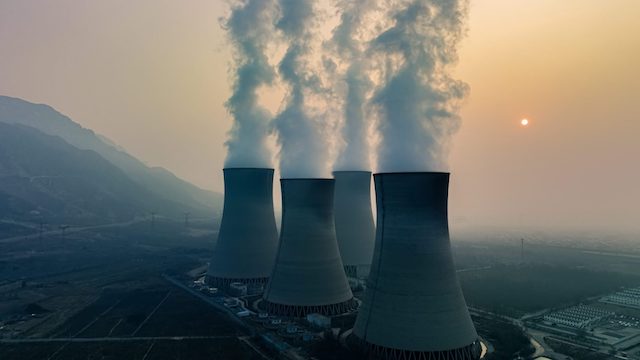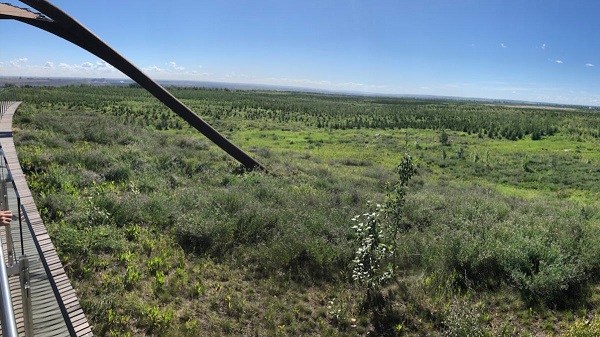Canadian Energy Centre
Canada should ‘shout from the rooftops’ its ability to reduce emissions with LNG

Morning view of a coal-fired power station in China. Getty Images photo
From the Canadian Energy Centre Ltd.
By James Snell and Deborah Jaremko
Canada should work with its allies and potential customers to receive credit for the global emissions reduction benefits of exporting liquefied natural gas (LNG), says a prominent Canadian energy advocate.
The equivalent of all Canadian GHG emissions could be eliminated by helping Asia switch 20 per cent of its coal fired power stations to natural gas, says Shannon Joseph, chair of Energy for a Secure Future, citing a recent report published by the Canadian Chamber of Commerce.
“Canada could help deliver 680 megatonnes of emissions reductions, and that’s more than our whole country,” she says.
“We should do it and shout it from the rooftops. We should move forward with LNG as an energy and emission solution.”
Receiving credit for lowering emissions with LNG could come through what’s known as Article 6 of the Paris Agreement, but Joseph says Canada need not wait for these carbon accounting rules to be settled before pressing forward.
“We need to assert, confidently, the environmental value we would be delivering to the world,” she says.

Shannon Joseph, chair of Energy for a Secure Future. Photo by Dave Chidley for the Canadian Energy Centre
Article 6 conceptually allows countries to collaborate with each other on emissions reduction goals by trading carbon credits. In theory, for example that could allow Canada receive credit for emissions reductions achieved in China by using Canadian LNG to displace coal.
The Paris Agreement signatories have not yet agreed on the rules to make Article 6 a reality. Meanwhile, driven by Asia, last year the world consumed more coal – and produced more emissions from that coal – than ever before, according to the International Energy Agency (IEA).
The IEA says switching from coal to natural gas for electricity generation reduces emissions by half on average. LNG from Canada can deliver an even bigger decrease, reducing emissions by up to 62 per cent, according to a June 2020 study published in the Journal for Cleaner Production.
Even before Russia’s invasion of Ukraine, world LNG demand was expected to nearly double by 2040. The market has become even tighter as countries work to exclude Russian energy, says a report by Energy for a Secure Future.
Japan and South Korea, as well as Germany have asked Canada to step up LNG development to help mitigate the energy crisis.
With or without Article 6, Energy for a Secure Future is calling on Canada to work with its potential customers in Europe and Asia to recognize and credit the environmental benefits of Canadian LNG displacing higher emitting energy.
“Canada’s allies have come here asking for energy, and we should work directly with them to find a way to have our environmental contributions recognized,” says Joseph, adding the U.S. has moved ahead without credits, more than doubling LNG exports since 2019.
Canada has yet to export significant volumes of LNG after years of regulatory delay and cancelled projects – but things are changing.
LNG Canada in Kitimat B.C. will be the first major export facility to operate, starting in 2025. Woodfibre LNG near Squamish begins construction this fall with the aim to start operating in 2027. Other proposed projects include the Indigenous-led Cedar LNG facility in Kitimat and Ksi Lisims LNG near Prince Rupert.

LNG Canada CEO Jason Klein stands atop a receiving platform overlooking LNG processing units called trains that are used to convert natural gas into liquefied natural gas at the LNG Canada export terminal under construction, in Kitimat, B.C., on Wednesday, September 28, 2022. CP Images photo
Meanwhile, India, China and Japan remain consumers of Russian oil and gas, according to the 2023 Statistical Review of World Energy.
“We are trying to help our allies meet the challenges they are facing. One of these is ensuring that their populations – sometimes of over a billion people – can even access modern forms of energy,” Joseph says.
“If Canada wants to be relevant and to lead, we have to come to the table with solutions to this question, alongside the environmental one. LNG is our biggest card.”
India will have the world’s largest population by 2028 – climbing to 1.45 billion and rising to 1.67 billion people by 2040, according to the United Nations Population Fund.
“Currently India is the fourth largest importer of LNG [in the world] and demand is expected to grow massively as 270 million people move up the socioeconomic ladder,” says Victor Thomas, CEO of the Canada-India Business Council.
Canada’s potential to deliver LNG to India “just makes good sense when you look at the geopolitical fractures that have occurred since 2022,” he says, noting the U.S. has recognized the opportunity and is taking action to form new business relationships in India.
Burning wood and other biomass for heat and cooking is still common in the South Asian country, while coal produces around three quarters of India’s electricity. According to the IEA, by 2040 India’s total energy demand will be 70 per cent higher than it was in 2019.
“Transitioning from wood burning to LNG is a massive emissions reduction,” says Thomas. “It’s a safe and reliable opportunity. People are looking for a country like Canada to be able to provide that.”
Canadian Energy Centre
Alberta oil sands legacy tailings down 40 per cent since 2015

Wapisiw Lookout, reclaimed site of the oil sands industry’s first tailings pond, which started in 1967. The area was restored to a solid surface in 2010 and now functions as a 220-acre watershed. Photo courtesy Suncor Energy
From the Canadian Energy Centre
By CEC Research
Mines demonstrate significant strides through technological innovation
Tailings are a byproduct of mining operations around the world.
In Alberta’s oil sands, tailings are a fluid mixture of water, sand, silt, clay and residual bitumen generated during the extraction process.
Engineered basins or “tailings ponds” store the material and help oil sands mining projects recycle water, reducing the amount withdrawn from the Athabasca River.
In 2023, 79 per cent of the water used for oil sands mining was recycled, according to the latest data from the Alberta Energy Regulator (AER).
Decades of operations, rising production and federal regulations prohibiting the release of process-affected water have contributed to a significant accumulation of oil sands fluid tailings.
The Mining Association of Canada describes that:
“Like many other industrial processes, the oil sands mining process requires water.
However, while many other types of mines in Canada like copper, nickel, gold, iron ore and diamond mines are allowed to release water (effluent) to an aquatic environment provided that it meets stringent regulatory requirements, there are no such regulations for oil sands mines.
Instead, these mines have had to retain most of the water used in their processes, and significant amounts of accumulated precipitation, since the mines began operating.”
Despite this ongoing challenge, oil sands mining operators have made significant strides in reducing fluid tailings through technological innovation.
This is demonstrated by reductions in “legacy fluid tailings” since 2015.
Legacy Fluid Tailings vs. New Fluid Tailings
As part of implementing the Tailings Management Framework introduced in March 2015, the AER released Directive 085: Fluid Tailings Management for Oil Sands Mining Projects in July 2016.
Directive 085 introduced new criteria for the measurement and closure of “legacy fluid tailings” separate from those applied to “new fluid tailings.”
Legacy fluid tailings are defined as those deposited in storage before January 1, 2015, while new fluid tailings are those deposited in storage after January 1, 2015.
The new rules specified that new fluid tailings must be ready to reclaim ten years after the end of a mine’s life, while legacy fluid tailings must be ready to reclaim by the end of a mine’s life.
Total Oil Sands Legacy Fluid Tailings
Alberta’s oil sands mining sector decreased total legacy fluid tailings by approximately 40 per cent between 2015 and 2024, according to the latest company reporting to the AER.
Total legacy fluid tailings in 2024 were approximately 623 million cubic metres, down from about one billion cubic metres in 2015.
The reductions are led by the sector’s longest-running projects: Suncor Energy’s Base Mine (opened in 1967), Syncrude’s Mildred Lake Mine (opened in 1978), and Syncrude’s Aurora North Mine (opened in 2001). All are now operated by Suncor Energy.
The Horizon Mine, operated by Canadian Natural Resources (opened in 2009) also reports a significant reduction in legacy fluid tailings.
The Muskeg River Mine (opened in 2002) and Jackpine Mine (opened in 2010) had modest changes in legacy fluid tailings over the period. Both are now operated by Canadian Natural Resources.
Imperial Oil’s Kearl Mine (opened in 2013) and Suncor Energy’s Fort Hills Mine (opened in 2018) have no reported legacy fluid tailings.
Suncor Energy Base Mine
Between 2015 and 2024, Suncor Energy’s Base Mine reduced legacy fluid tailings by approximately 98 per cent, from 293 million cubic metres to 6 million cubic metres.
Syncrude Mildred Lake Mine
Between 2015 and 2024, Syncrude’s Mildred Lake Mine reduced legacy fluid tailings by approximately 15 per cent, from 457 million cubic metres to 389 million cubic metres.
Syncrude Aurora North Mine
Between 2015 and 2024, Syncrude’s Aurora North Mine reduced legacy fluid tailings by approximately 25 per cent, from 102 million cubic metres to 77 million cubic metres.
Canadian Natural Resources Horizon Mine
Between 2015 and 2024, Canadian Natural Resources’ Horizon Mine reduced legacy fluid tailings by approximately 36 per cent, from 66 million cubic metres to 42 million cubic metres.
Total Oil Sands Fluid Tailings
Reducing legacy fluid tailings has helped slow the overall growth of fluid tailings across the oil sands sector.
Without efforts to reduce legacy fluid tailings, the total oil sands fluid tailings footprint today would be approximately 1.6 billion cubic metres.
The current fluid tailings volume stands at approximately 1.2 billion cubic metres, up from roughly 1.1 billion in 2015.
The unaltered reproduction of this content is free of charge with attribution to the Canadian Energy Centre.
Business
Why it’s time to repeal the oil tanker ban on B.C.’s north coast

The Port of Prince Rupert on the north coast of British Columbia. Photo courtesy Prince Rupert Port Authority
From the Canadian Energy Centre
By Will Gibson
Moratorium does little to improve marine safety while sending the wrong message to energy investors
In 2019, Martha Hall Findlay, then-CEO of the Canada West Foundation, penned a strongly worded op-ed in the Globe and Mail calling the federal ban of oil tankers on B.C.’s northern coast “un-Canadian.”
Six years later, her opinion hasn’t changed.
“It was bad legislation and the government should get rid of it,” said Hall Findlay, now director of the University of Calgary’s School of Public Policy.
The moratorium, known as Bill C-48, banned vessels carrying more than 12,500 tonnes of oil from accessing northern B.C. ports.
Targeting products from one sector in one area does little to achieve the goal of overall improved marine transport safety, she said.
“There are risks associated with any kind of transportation with any goods, and not all of them are with oil tankers. All that singling out one part of one coast did was prevent more oil and gas from being produced that could be shipped off that coast,” she said.
Hall Findlay is a former Liberal MP who served as Suncor Energy’s chief sustainability officer before taking on her role at the University of Calgary.
She sees an opportunity to remove the tanker moratorium in light of changing attitudes about resource development across Canada and a new federal government that has publicly committed to delivering nation-building energy projects.
“There’s a greater recognition in large portions of the public across the country, not just Alberta and Saskatchewan, that Canada is too dependent on the United States as the only customer for our energy products,” she said.
“There are better alternatives to C-48, such as setting aside what are called Particularly Sensitive Sea Areas, which have been established in areas such as the Great Barrier Reef and the Galapagos Islands.”
The Business Council of British Columbia, which represents more than 200 companies, post-secondary institutions and industry associations, echoes Hall Findlay’s call for the tanker ban to be repealed.
“Comparable shipments face no such restrictions on the East Coast,” said Denise Mullen, the council’s director of environment, sustainability and Indigenous relations.
“This unfair treatment reinforces Canada’s over-reliance on the U.S. market, where Canadian oil is sold at a discount, by restricting access to Asia-Pacific markets.
“This results in billions in lost government revenues and reduced private investment at a time when our economy can least afford it.”
The ban on tanker traffic specifically in northern B.C. doesn’t make sense given Canada already has strong marine safety regulations in place, Mullen said.
Notably, completion of the Trans Mountain Pipeline expansion in 2024 also doubled marine spill response capacity on Canada’s West Coast. A $170 million investment added new equipment, personnel and response bases in the Salish Sea.
“The [C-48] moratorium adds little real protection while sending a damaging message to global investors,” she said.
“This undermines the confidence needed for long-term investment in critical trade-enabling infrastructure.”
Indigenous Resource Network executive director John Desjarlais senses there’s an openness to revisiting the issue for Indigenous communities.
“Sentiment has changed and evolved in the past six years,” he said.
“There are still concerns and trust that needs to be built. But there’s also a recognition that in addition to environmental impacts, [there are] consequences of not doing it in terms of an economic impact as well as the cascading socio-economic impacts.”
The ban effectively killed the proposed $16-billion Eagle Spirit project, an Indigenous-led pipeline that would have shipped oil from northern Alberta to a tidewater export terminal at Prince Rupert, B.C.
“When you have Indigenous participants who want to advance these projects, the moratorium needs to be revisited,” Desjarlais said.
He notes that in the six years since the tanker ban went into effect, there are growing partnerships between B.C. First Nations and the energy industry, including the Haisla Nation’s Cedar LNG project and the Nisga’a Nation’s Ksi Lisims LNG project.
This has deepened the trust that projects can mitigate risks while providing economic reconciliation and benefits to communities, Dejarlais said.
“Industry has come leaps and bounds in terms of working with First Nations,” he said.
“They are treating the rights of the communities they work with appropriately in terms of project risk and returns.”
Hall Findlay is cautiously optimistic that the tanker ban will be replaced by more appropriate legislation.
“I’m hoping that we see the revival of a federal government that brings pragmatism to governing the country,” she said.
“Repealing C-48 would be a sign of that happening.”
-

 Agriculture2 days ago
Agriculture2 days agoCanada’s supply management system is failing consumers
-

 Alberta1 day ago
Alberta1 day agoAlberta uncorks new rules for liquor and cannabis
-

 Energy19 hours ago
Energy19 hours agoB.C. Residents File Competition Bureau Complaint Against David Suzuki Foundation for Use of False Imagery in Anti-Energy Campaigns
-

 COVID-1919 hours ago
COVID-1919 hours agoCourt compels RCMP and TD Bank to hand over records related to freezing of peaceful protestor’s bank accounts
-

 Crime1 day ago
Crime1 day agoProject Sleeping Giant: Inside the Chinese Mercantile Machine Linking Beijing’s Underground Banks and the Sinaloa Cartel
-

 International1 day ago
International1 day agoTrump transportation secretary tells governors to remove ‘rainbow crosswalks’
-

 Alberta23 hours ago
Alberta23 hours agoAlberta Next: Alberta Pension Plan
-

 C2C Journal17 hours ago
C2C Journal17 hours agoCanada Desperately Needs a Baby Bump








